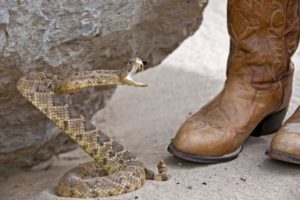 Snakeproof boots are a buffer that promises to keep fangs away from your skin, whether they’re venomous or non-venomous.
Snakeproof boots are a buffer that promises to keep fangs away from your skin, whether they’re venomous or non-venomous.
Although the number of Americans dying from snakebites is less than 16 out of approximately 8000 victims every year (statistics from the Department of Wildlife Ecology and Conservation at the University of Florida), it is still not a 0 to give you complete peace of mind.
If you’re a survivor, then the reading-between-the-lines meaning of it is, you survived after enduring hours of pain and medical treatments.
You can choose a location for hiking/hunting after checking snake activity in the area or watch your steps all you want during the excursion, an unexpected snake confrontation is a part of that scene, regardless.
That is why wearing appropriate protective apparel both for hunting and hiking is non-negotiable.
Snake boots are crafted from really rigid materials to shield you from fangs.
They employ special features to make them snakeproof. However, one cannot get rid of the “what if” question, i.e. what if they don’t work?
Some manufacturing companies put their boots through an experimental stage of real rattlesnake bites to show that these boots are capable of doing their job, eliminating the doubts.
Table of Contents
Here’s an Answer to Do Snakes Proof Boots Really Work
While it is common knowledge that snakeproof boots do not offer 100% protection against snake fangs in some cases, they’re still your best shot at coming out unscathed and alive from a trip to snake-infested territory, especially if the area is populated with poisonous ones like rattlers and copperheads.
That answers your question about whether they work or not.
Now, the next pressing question is why they work in some cases and not in others? Simple and obvious reasons can be the varying quality of the boots and the assets the culprit snake possesses.
How Do Snakeproof Boots Protect from Snakebites?
The word “snakeproof” indicates that this footwear is made of puncture-proof material. Usually, the companies prefer Cordura nylon, leather, denim, neoprene, rubber, polyurethane or Kevlar for the manufacturing of these boots.
The reason is their resilience and endurance to not let the needle-sharp fangs pierce through the material to come close to the skin.
There’s also a special snake guard layer squeezed between the outermost and innermost lining of the boot to make sure not even the longest and sharpest pair of fangs can penetrate the material.
The layer is flexible enough to not make a hunter’s/hiker’s feet feel like they’re enclosed in a cast.
Since a snakebite will lead a person to hours of pain and suffering, if not death, a majority of the reputable brands test their products on live snakes.
For instance, snake boots by Thorogood and Lacrosse are subjected to bites of real rattlesnakes before they’re made available to the public. This not only grants reliability to their gears but also brings peace of mind to the customers.
What are the Other Mandatory Features for Snakeboots?
Material isn’t the only thing that guards one against fangs. Some other factors are also considered mandatory, such as coverage and comfort.
Coverage:
It is a simple rule of thumb, the higher the snakeproof boots go above your calf, the lower will be the chances of fangs puncturing your skin.
When you’re climbing over a rock, walking through a forest or a hiking trail, your lower leg (from ankle to knee) is the most easily accessible part for a snake. That is why the manufacturers prefer shaft lengths between 16 to 18 inches.
Thus, even if a snake manages to crawl up your foot or longes with the intent to bite, the knee-high boots do not give it the opening to strike directly on your limb.
Comfort:
Like toughness, comfort is also a rudimentary part. Ask yourself, would you be able to wear boots that make your feet too stuffy that they sweat like a pig or too stiff to chafe skin and form blisters? Hell No!
These boots have cushioned insoles and paddings to surround feet in comfort.
As for the stuffiness, reliable companies add breathable and moisture-absorbing lining to prevent sweating and stinking.
A bit of free advice for all, reject a pair of boots that lack waterproofing because they will become a liability rather than an asset when it rains or you have to cross marshes and river streams.
Can Snake Bite Through Rubber or Leather Boots?
The length of snake fangs and the strength with which they strike vary. Regular rubber and leather boots lack protective features designed to combat aggressive snakebites.
The possibility of fangs penetrating through rubber boots is higher than through leather boots because leather is a lot tougher than rubber.
Also, it will take a hefty amount of force for a snake to puncture through sturdy leather material. Luckily, not all snakes possess that kind of strength and power.
However, do you really want to take that chance when it’s your well-being on the line? Nope. It will be in your best interest to invest in snakeproof boots and pair them with gaiters or snakeproof chaps to make sure you’re 100% protected.
Conclusion
Snakeproof boots are your insurance to come back from an outdoor excursion snakebite-free because of their protective features. These boots form an impenetrable barrier between your body and those fangs that promise either pain, death or both. If you invest in these protective gears for outdoors, you’re saving your future and money; money that you would have to spend on medical bills and medication if bitten by a snake. So, decide wisely.
